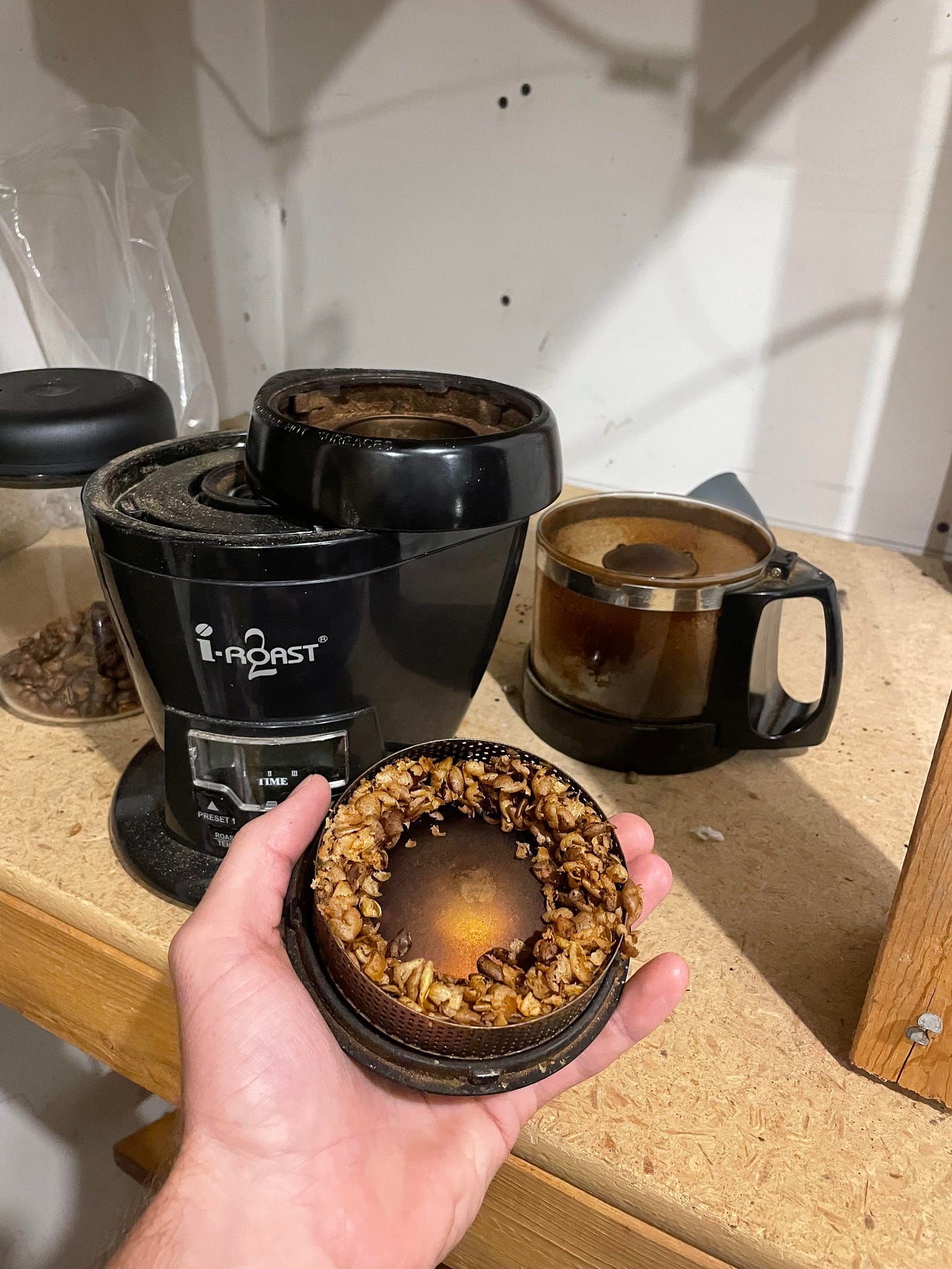We have all seen the Hydro flask stickers: “Coffee gets me started, Jesus keeps me going.” Nothing will show your non-denominational, big box mega church heritage quicker than a cheesy sticker on a banged up 32 ounce water bottle. I have learned a great deal from the coffee roasting process. Here are my thoughts…
For Christmas in 2022, my mother-in-law got me a coffee roaster passed down from a friend. It is an old Hearthware i-Roast 2 made in 2001 (I was 3 years old). This company is now called Nuwave and no longer sells coffee roasters. Nonetheless, I started to get into higher quality coffees and this was the perfect next step for me. Essentially the machine is a vertical hair dryer with a chaff collector in the lid. This machine gets up to 455°F and is VERY LOUD.
I put raw green coffee beans, which are the pits of a cranberry-like fruit, into my roaster and start the thing up. The machine heats up the beans and the air pushes them through a cone to keep them moving and spread the heat evenly across the beans. After a few minutes, the beans go through what is called ‘first crack’. This is the point where the internal core of the beans have reached 385°F and they produce a cracking sound because they fracture and release CO₂. After all of the beans have cracked the first time, they are then consumable and if you stopped the roaster then, the batch would be a light roast. This roast, depending on the coffee, is usually fruity (most people would say the word sour) because that is what coffee tastes like. We’re talking about an acidic fruit here, people. If you wanted to dampen the citrusy flavor, you would continue to roast the beans just before or just after the second crack, which would be medium or dark roast. This occurs at 435°F and as the cellular structure of the beans breaks down, more CO₂ is expressed on the surface of the beans (when you see glossy beans you know that they have been through second crack). Some sweetening and caramelization occurs between first and second crack and this what what most people think of and prefer when it comes to coffee flavor. It also pairs better with milk and sugar in this state. Typically, darker roasted beans provide more body to the coffee, which means the liquid is thicker and if you roast too light, the coffee will have the consistency of tea. I hope that was interesting because I just decided to nerd out a little bit there.
Here is the part that I love about roasting. After the first crack, thin husks on the raw coffee begin to shed off of the beans. This is the chaff and it is blown vertically into the chaff collector by the hot air. This reminds me of Mathew 3:12, in which John the Baptist says, “His winnowing fork is in his hand, and he will clear his threshing floor and gather his wheat into the barn, but the chaff he will burn with unquenchable fire.” When I see the chaff shedding from the beans, I think of this judgement. This is not a dour thing to witness, but a perpetual reminder that Jesus was given a people as a possession.
“But you are a chosen race, a royal priesthood, a holy nation, a people for his own possession, that you may proclaim the excellencies of him who called you out of darkness into his marvelous light. Once you were not a people, but now you are God's people; once you had not received mercy, but now you have received mercy.”
(1 Peter 2:9-10 ESV)
Just like the people of God must lay down their lives, go into the grave, and come out born again in new life. So must the nature of the coffee be changed through unbearable heat. The product is a new kind of bean. The individual beans are then unified into one collective church of grounds, purified by water, and sanctified through the filter. The end result is a glorious Cup of Joe. I think there’s something in the Bible about milk and honey too





Love it. A fun “lighter roast” topic! I love finding the gospel in the world around us.